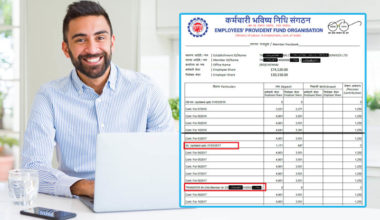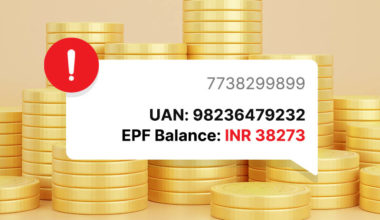A government backed savings scheme, with high returns and low risk, VPF full form is Voluntary Provident Fund. It is a type of provident fund scheme in which an employee/depositor can maintain a significant part of his/her provident fund voluntarily. As the name suggests, any employee who wishes to avail the VPF scheme must contribute a part of his/her income towards the fund.
Let’s learn more about the Voluntary Provident Fund, its features, benefits, eligibility conditions and more in this blog!
Understanding VPF – Features
The employee’s contribution towards VPF should be over and above his/her contribution to EPF. This means that an employee is bound to contribute 12% of his/her basic salary and dearness allowance to EPF, so his/her contribution to VPF should be over the 12% contributed to EPF. However, there is no minimum or maximum limit on the amount of contribution made towards VPF.
Listed below are some of the salient features of VPF-
- Employees can contribute a maximum of 100% of their basic salary and dearness allowance towards their VPF account
- An employee’s VPF is associated with his/her EPF account only; thus, there is no separate VPF account for any employee
- Only salaried employees working in any organization which is duly recognized by the EPFO can avail of the VPF scheme
- Individuals who are working in the unorganized sectors or are self employed cannot make use of the VPF scheme
- There is no obligation for any employee to contribute to this scheme. As the name suggests, VPF is an entirely voluntary scheme
- The lock-in period for a VPF is 5 years; no employee can withdraw his/her funds from the VPF account before this maturity period
- Employees are allowed to make partial/complete withdrawals from their VPF account. However, such withdrawals would be subject tax implications
- Employees can avail the entire maturity amount in their VPF account upon retirement or resignation
- The funds accumulated in a VPF account can be transferred from one employer to the other as in the case of EPF
VPF Benefits
Explained below are some of the reasons why you should consider investing in a voluntary provident fund-
- Since it is governed by the government of India, VPF is a safe and secure investment option
- Employees can make partial/complete withdrawals from their VPF account
- Investments in VPF are made from the pre-tax income of the employer
- Employee’s contribution towards VPF is subject to a deduction of a maximum of Rs. 1.5 lakh
- The income on the accumulated fund in VPF is non-taxable until the interest reaches a rate of 8.5%
- The withdrawals made after 5 years of investing are tax-free
- The interest rate on VPF is quite high, owing to which investors can expect better returns
- VPF withdrawals can be made at the time of retirement or at the time of resignation from the current employer. Hence, these funds offer multiple benefits for the post retirement period
- Investments in the VPF account are entitled to a tax deduction of upto Rs. 1 lakh
- In case of sudden death of the investor, the entire amount accumulated in the VPF account will be paid to the nominee or legal heir of the employee
VPF Eligibility Conditions
Following are some of the mandatory conditions that an employee should meet in order to be eligible to invest in VPF-
- The investor must be a salaried employee who receives a monthly salary in his/her salary account
- The employee must have an active EPF account
Documents Required to Open a VPF Account
An employee must present the following documents to open a VPF account-
- Company Registration Certificate with the Ministry of Finance (MoF)
- Form 24
- Form 49
- Detailed company profile
- Business registration certificate
- Memorandum and articles of association if the organization is ‘Sdn Bhd’
VPF Interest Rate
The VPF interest rate is regulated by the Government of India and is declared at the beginning of every financial year. This also helps employees to forecast their tax payments and plan their financial year ahead. Since the interest rates are announced every year, it is likely that these rates fluctuate both ways. It must be noted that the interest offered on VPF is in accordance with the EPF scheme and is credited to the employee’s EPF account.
Listed below are the interest rates on VPF for the last 5 years-
| Year | Interest on VPF |
| 2021-2022 | 8.10% |
| 2019-2020 | 8.5% |
| 2018-2019 | 8.65% |
| 2017-2018 | 8.5% |
| 2016-2017 | 8.8% |
VPF Withdrawals
Investors/employees are permitted to withdraw funds from their VPF account in case of medical emergencies. Additionally, employees can withdraw funds from their VPF account in the following cases-
- Medical emergencies
- Wedding of the account holder
- Higher education of the account holder
- Purchase of a new land/house
- Construction of a new house
To do so, it is mandatory for the employee to fill Form-31 and a withdrawal request letter in writing. The employee must submit the following details for VPF withdrawal-
- PF account number
- Postal address
- Bank details in which the withdrawal amount can be transferred
- Canceled cheque
- Form 31
- Withdrawal request letter in writing
VPF Tax Benefit
Following are some of the VPF tax benefits for employees-
- Employees are allowed to make partial/complete withdrawals from their VPF account. However, such withdrawals would be subject tax implications
- Investments in VPF are made from the pre-tax income of the employer
- Employee’s contribution towards VPF is subject to a deduction of a maximum of Rs. 1.5 lakh
- The income on the accumulated fund in VPF is non-taxable until the interest reaches a rate of 8.5%
- The withdrawals made after 5 years of investing are tax-free
- Investments in the VPF account are entitled to a tax deduction of upto Rs. 1 lakh
Wrapping it Up:
A VPF account is quite similar to an EPF account. The only major difference between the both is that the 12% salary contribution of the employee goes directly to the EPF account, whereas the contribution to VPF account should be made separately. Since the scheme is governed by the government of India, it is a safe and secure investment option for employees, offering post-retirement benefits. Moreover, VPF investments also offer multiple tax benefits to its investors.
Related News
EPFO Raises Provident Fund Interest Rate to 8.25% for 2023-24
EPFO Discontinues Acceptance of Aadhaar Card as Proof of Date of Birth










